By Edwin Guevara
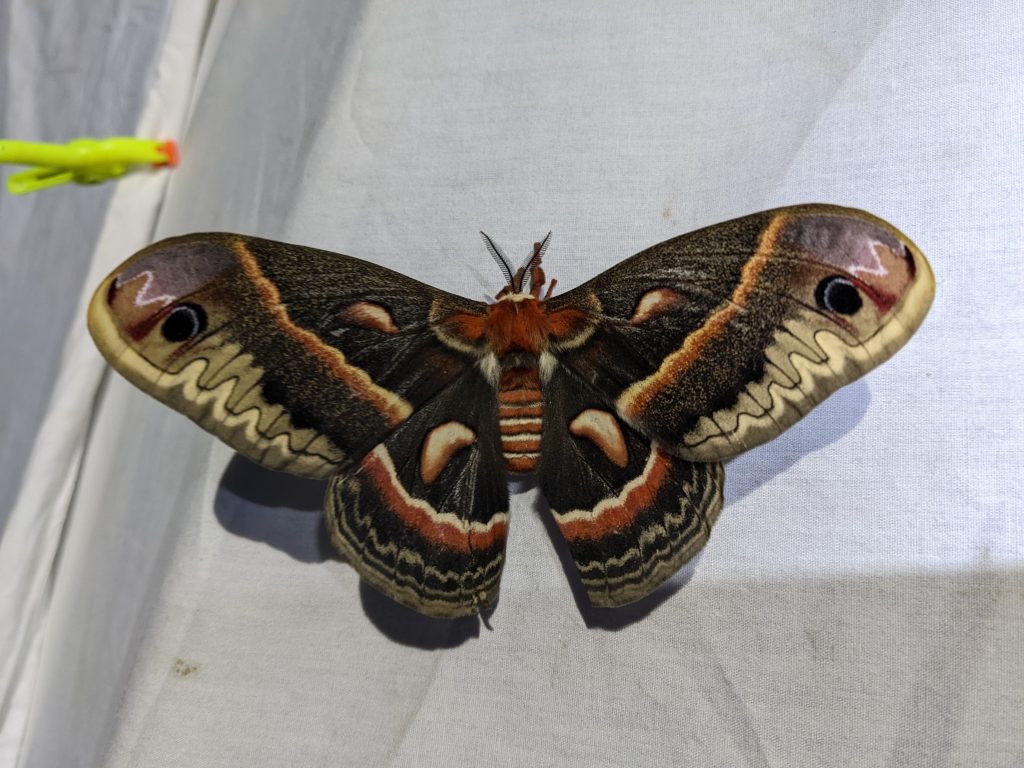
Cecropia moth (Hyalophora cecropia) on a blanket during a “Moth Night’ outing.” Photo by Edwin Guevara, Maryland Department of Natural Resources
Are you looking for ways to get out and explore in your area? While it is always fun to go outside on hikes and explore and identify the local flora and fauna using guidebooks, apps, or your own knowledge, sometimes you want to have a bigger assortment of options. Many naturalists contribute to community science through apps like iNaturalist and eBird, along with other enthusiasts and experts in the field — you can read more about nature activity apps in a past edition of HabiChat. This article will provide you information about outdoor activities designed to discover some of the best wildlife Maryland has to offer.
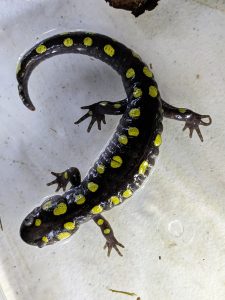
Spotted salamander (Ambystoma maculatum), photo by Edwin Guevara, Maryland DNR
Groups like the Susquehannock Wildlife Society and the Natural History Society of Maryland host activities like Moth Nights and Vernal Pool Hikes. These activities offer the public the opportunity to experience nature at night and see areas that would otherwise be inaccessible.
Moth nights usually include a short hike to a dark area of the forest, and then the organizers set up a few hanging white blankets and a bright light to attract the moths. There are plenty of Lepidopteran enthusiasts around to help folks identify the species and plenty of time to photograph the moths.
Vernal Pool Hikes are offered by many groups in Maryland. I have visited the ones held by the Susquehannock Wildlife Society as well as the Natural History Society of Maryland, and they are both phenomenal. Usually after dusk in the weeks around the end of March, these hikes are organized to show people the emergence of amphibians and macroinvertebrates in the spring. Volunteers who lead these hikes are very knowledgeable, and between the great information they provide and the awesome critters you find, it makes for a memorable time.
Another great nature idea for dusky times are bat walks, where a hike leader will first discuss why bats are so important for the ecosystem and which local species are expected to be observed. Then you will go on a short hike that ends in a meadow or field. It is a good idea to bring a small blanket to sit on as you wait for the sun to go down and the bats to come out. The person leading the walk will use a bat detector that accompanies an app for smartphones. Together the app and detector can listen for and identify local species of bats as they use echolocation.
When it comes to fun activities that can be done during the day, one awesome option is a bioblitz, described by iNaturalist as a “communal citizen-science effort to record as many species within a designated location and time period as possible. Bioblitzes are great ways to engage the public to connect to their environment while generating useful data for science and conservation. They are also an excuse for naturalists, scientists, and curious members of the public to meet in person in the great outdoors and are a lot of fun!”
Many state and county parks as well as nonprofit organizations, schools, and communities host bioblitzes year round — just do an internet search for bioblitzes near you or work to organize your own! The iNaturalist website includes a bioblitz guide with all the information necessary to find, join, or organize a bioblitz.
The City Nature Challenge is basically a bioblitz-styled competition in which cities engage in a friendly contest to see who can make the most observations of nature, find the most species, and engage the public. The City Nature Challenge website includes information on how to join, learn to use a toolkit with students, or become a city organizer. These are wonderful opportunities to merge technology with nature using apps to help you identify plants, animals, and fungi.
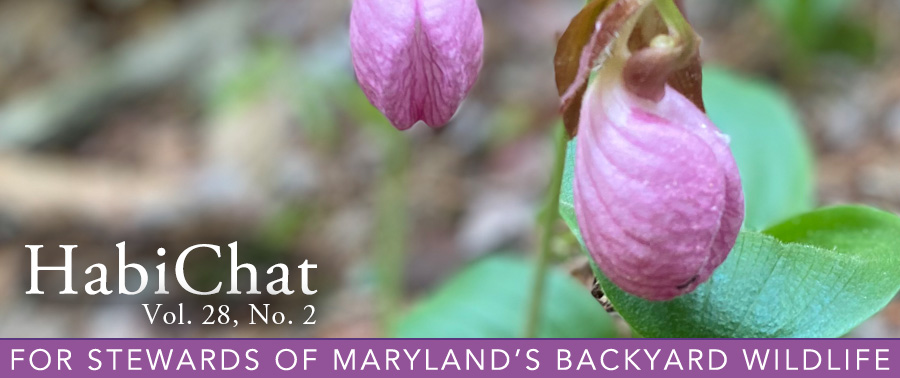
Visit Us Online!

Cecropia moth (Hyalophora cecropia) on a blanket during a “Moth Night’ outing.” Photo by Edwin Guevara, Maryland Department of Natural Resources
Are you looking for ways to get out and explore in your area? While it is always fun to go outside on hikes and explore and identify the local flora and fauna using guidebooks, apps, or your own knowledge, sometimes you want to have a bigger assortment of options. Many naturalists contribute to community science through apps like iNaturalist and eBird, along with other enthusiasts and experts in the field — you can read more about nature activity apps in a past edition of HabiChat. This article will provide you information about outdoor activities designed to discover some of the best wildlife Maryland has to offer.

Spotted salamander (Ambystoma maculatum), photo by Edwin Guevara, Maryland DNR
Groups like the Susquehannock Wildlife Society and the Natural History Society of Maryland host activities like Moth Nights and Vernal Pool Hikes. These activities offer the public the opportunity to experience nature at night and see areas that would otherwise be inaccessible.
Moth nights usually include a short hike to a dark area of the forest, and then the organizers set up a few hanging white blankets and a bright light to attract the moths. There are plenty of Lepidopteran enthusiasts around to help folks identify the species and plenty of time to photograph the moths.
Vernal Pool Hikes are offered by many groups in Maryland. I have visited the ones held by the Susquehannock Wildlife Society as well as the Natural History Society of Maryland, and they are both phenomenal. Usually after dusk in the weeks around the end of March, these hikes are organized to show people the emergence of amphibians and macroinvertebrates in the spring. Volunteers who lead these hikes are very knowledgeable, and between the great information they provide and the awesome critters you find, it makes for a memorable time.
Another great nature idea for dusky times are bat walks, where a hike leader will first discuss why bats are so important for the ecosystem and which local species are expected to be observed. Then you will go on a short hike that ends in a meadow or field. It is a good idea to bring a small blanket to sit on as you wait for the sun to go down and the bats to come out. The person leading the walk will use a bat detector that accompanies an app for smartphones. Together the app and detector can listen for and identify local species of bats as they use echolocation.
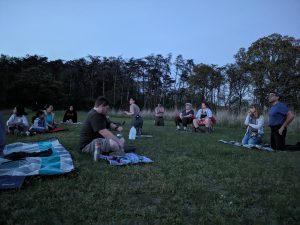
Left: People attending a bat walk at Soldiers Delight. Photo by Edwin Guevara | 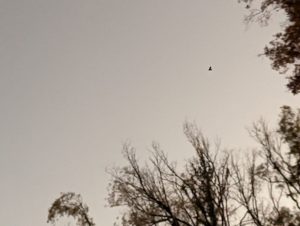
Right: Big brown bat in flight, photo by Edwin Guevara |
When it comes to fun activities that can be done during the day, one awesome option is a bioblitz, described by iNaturalist as a “communal citizen-science effort to record as many species within a designated location and time period as possible. Bioblitzes are great ways to engage the public to connect to their environment while generating useful data for science and conservation. They are also an excuse for naturalists, scientists, and curious members of the public to meet in person in the great outdoors and are a lot of fun!”
Many state and county parks as well as nonprofit organizations, schools, and communities host bioblitzes year round — just do an internet search for bioblitzes near you or work to organize your own! The iNaturalist website includes a bioblitz guide with all the information necessary to find, join, or organize a bioblitz.
The City Nature Challenge is basically a bioblitz-styled competition in which cities engage in a friendly contest to see who can make the most observations of nature, find the most species, and engage the public. The City Nature Challenge website includes information on how to join, learn to use a toolkit with students, or become a city organizer. These are wonderful opportunities to merge technology with nature using apps to help you identify plants, animals, and fungi.

Visit Us Online!
